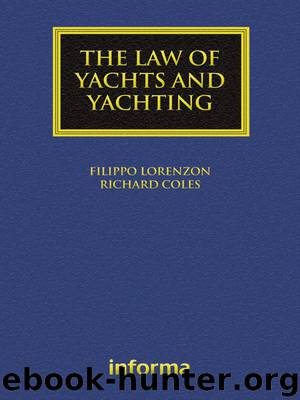The Law of Yachts and Yachting by Filippo Lorenzon Richard Coles

Author:Filippo Lorenzon, Richard Coles
Language: eng
Format: epub
Publisher: Informa Law from Routledge
CHAPTER 9
Mooring
1. Introduction
2. Marinas
3. Rights and liabilities
1. INTRODUCTION
[9-001] Introduction. The first preoccupation of any yacht owner is where to keep her. Indeed, the cost of a permanent mooring, particularly in a purpose-built marina, is likely to be the largest single item in the annual budget if the owner does not employ a professional crew. The substantial number of new boats coming onto the market, and the long life of yachts made of GRP,1 means that the demand for marina berths is ever-increasing. Not all yachts are moored in marinas, however. The traditional swinging mooring is still to be seen in the creeks and natural harbours around the coasts of England and elsewhere, but their numbers are dwindling as harbour commissioners seek to make better use of the available space with trots (where the craft is secured fore and aft in line with the current or tidal stream) and marinas.2 Most major commercial ports around the world now have facilities for yachts, and indeed many of them have converted former commercial docks, which have become redundant due to the growth of containerised shipping of dry cargo, into yacht marinas. One of the first was St Katherines Dock, downstream of Tower Bridge in London. The underlying legislation governing the port is usually a statute dating from the nineteenth century,3 but which is still applicable to ships calling at the port, including yachts. Byelaws are also adopted and published by the local Port Authority.4
[9-002] The definition of “mooring”. The definition of what constitutes a mooring has been discussed in many cases over the years.5 Lord Esher MR, in the 1897 case of Attorney-General v Wright,6 stated that “It is such a mode of anchoring a vessel by means of fastening in the ground, either an anchor or something heavy, and a chain and buoy, as will allow of the vessel picking up the buoy when she returns to it, and so coming to rest”.7 The learned judge further stated that “every one knows who knows anything about navigation that there are two ways of anchoring a ship. There is the temporary anchoring by means of an anchor, which is lifted when necessary, and there is the more permanent mode by means of moorings”.8
[9-003] A more recent example is Evans v Godber.9 This was an appeal by the defendant Mr Evans, against the conviction that he had moored his 6.7-metre (22-foot) yacht within the Pagham harbour nature reserve contrary to the relevant byelaw,10 which prohibited “launching, mooring or leaving any boat within the reserve”. The defendant contended that he did not moor his yacht on the day in question but that he anchored his yacht. Dictionaries were consulted by the court and, as an example, “Mooring” in Bouviers Dictionary11 was defined as, “The securing of a vessel by a hawser or chain, or otherwise, to the shore, or to the bottom by a cable and anchor”. It was held that the defendant had undoubtedly secured his boat to the bottom by a cable and anchor.
Download
This site does not store any files on its server. We only index and link to content provided by other sites. Please contact the content providers to delete copyright contents if any and email us, we'll remove relevant links or contents immediately.
The Thirst by Nesbo Jo(6777)
Permanent Record by Edward Snowden(5705)
The Myth of the Strong Leader by Archie Brown(5390)
Spare by Prince Harry The Duke of Sussex(5022)
A Higher Loyalty: Truth, Lies, and Leadership by James Comey(4813)
Secrecy World by Jake Bernstein(4608)
Adulting by Kelly Williams Brown(4458)
The Borden Murders by Sarah Miller(4210)
Machine Learning at Scale with H2O by Gregory Keys | David Whiting(4016)
Killers of the Flower Moon by David Grann(3916)
American Kingpin by Nick Bilton(3730)
Fear by Bob Woodward(3604)
The Secret Barrister by The Secret Barrister(3587)
Future Crimes by Marc Goodman(3482)
The Last Girl by Nadia Murad(3414)
The House on Mango Street by Sandra Cisneros(3370)
Liar's Poker by Michael Lewis(3340)
The Social Psychology of Inequality by Unknown(2916)
Graduate Admissions Essays, Fourth Edition: Write Your Way into the Graduate School of Your Choice (Graduate Admissions Essays: Write Your Way Into the) by Asher Donald(2848)
